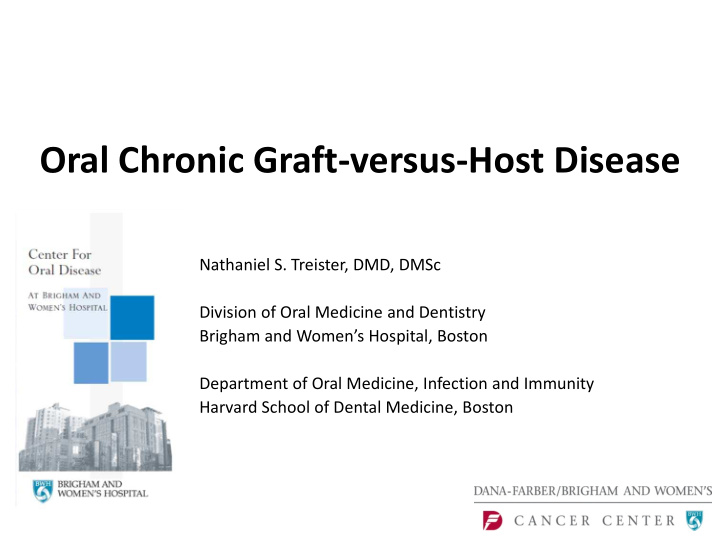



Oral Chronic Graft-versus-Host Disease Nathaniel S. Treister, DMD, DMSc Division of Oral Medicine and Dentistry Brigham and Women’s Hospital, Boston Department of Oral Medicine, Infection and Immunity Harvard School of Dental Medicine, Boston
Oral cGVHD is very common Flowers M, et al. Blood 2002;100:415-419
Oral chronic graft-versus-host disease • Prominent site of cGVHD • Wide range of signs/symptoms • Lichenoid inflammation • Dry mouth, cavities • Oral cancer risk
Oral cGVHD features • Resembles immune/autoimmune conditions – lichen planus – Sjögren syndrome – scleroderma • Frequently refractory to systemic therapy – important role for ancillary care
Treister N, et al. Blood 2012;120:3407-3418
Management of mucosal cGVHD • High potency topical corticosteroids – clobetasol 0.05% gel – fluocinonide 0.05% gel – dexamethasone 0.5 mg/5 mL (5 min swish/spit) – clobetasol 0.05% solution (compound) • Topical tacrolimus – Protopic 0.1% ointment (lips) – tacrolimus 0.5 mg/5 mL (compound) • Combination therapy
Common infectious complications • Yeast infection – contributing factors • topical steroid therapy • immunosuppression • dry mouth – management • Herpes simplex virus – immunosuppression – “breakthrough” infections – acyclovir/valacyclovir
Salivary gland cGVHD • Functions of saliva – lubrication/mastication – antimicrobial – buffering/remineralization • Quantitative/Qualitative changes – xerostomia/pain/discomfort – difficulty eating/swallowing – dental caries • cervical, interproximal – recurrent candidiasis Kaufman E, et al. Crit Rev Oral Biol Med 2002;13:197-212
16 months post allogeneic transplantation
Management of salivary cGVHD • Saliva substitutes, stimulants, sialogogue therapy • Caries prevention – brushing/flossing/diet – fluoride • trays w/ 1.1%/0.4% • varnish – remineralizing agents • Routine dental visits – bitewing radiographs – caries control • Recurrent candidiasis
Risk of second cancers Ades L, et al. Blood Reviews 2002;16:135-46
Oral cGVHD Summary • Common, may be initial site of cGVHD • Wide range of signs/symptoms • Management – topical corticosteroids & tacrolimus – avoid irritating food/drink/toothpaste – salivary stimulants & moisturizing agents, sialogogues, fluoride, mild/child’s toothpaste • Routine dental visits with radiographs • Oral cancer surveillance • May require treatment for many years
Common Oral cGVHD Prescriptions Mucosal cGVHD Salivary Gland cGVHD Rinses Stimulants & Moisturizing • • Agents – Best for generalized/extensive involvement – Biotene mouthwash/gel – 5 minutes, 2-4x/day – Sugar-free candy/gum – Dexamethasone 0.1 mg/mL Prescription stimulants • solution – Pilocarpine 5 mg 3x/day – Tacrolimus 0.1 mg/mL solution – Cevimeline 30 mg 3x/day (must be compounded) Fluoride (caries prevention) • Gels • – Prevident 5000 – Good for limited involvement – Apply nightly – Dry affected area, can apply (brush on or in custom trays) with gauze Remineralization • – Fluocinonide 0.05% gel – GC MI Paste Plus – Clobetasol 0.05% gel
Treister N, et al. Blood 2012;120:3407-3418
Recommend
More recommend